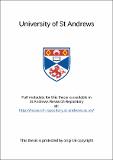Files in this item
1, 2, 4 - triazines and 1, 2, 4, 5 - tetrazines as monomers for Diels-Alder polymerisations
Item metadata
| dc.contributor.advisor | Smith, D. M. | |
| dc.contributor.author | Bruce, Michael John | en |
| dc.coverage.spatial | 92 p. | en |
| dc.date.accessioned | 2021-04-08T09:15:41Z | |
| dc.date.available | 2021-04-08T09:15:41Z | |
| dc.date.issued | 1995 | |
| dc.identifier.uri | https://hdl.handle.net/10023/22571 | |
| dc.description.abstract | Chapter 1 (Introduction) comprises a brief overview of the origins, mechanism and scope of the Diels-Alder reaction. It deals with the three different Diels Alder reaction types and highlights the utilisation of the reaction in general terms for the synthesis of aromatic and heteroaromatic ring systems. Particular attention has been paid to the inverse electron-demand Diels-Alder reactions of nitrogen-containing heterocycles, where aromatisation is brought about by the thermodynamically-driven loss of molecular nitrogen, leading to both carbocyclic and heterocyclic ring systems. Chapter 2 (Results and Discussion) develops the ideas formed in Chapter 1 to seek possible bis-dienes and bis-dienophiles for utilisation in polymer synthesis. Attention has been concentrated on possible routes to bis-l,2,4-triazines and 1,2,4,5- tetrazines, which are novel compounds, and on their possible use in both inter- and intra-molecular Diels-Alder reactions. A new method for the synthesis of bis-glyoxals involving the oxidation of the corresponding diacetyl-aromatics using HBr/DMSO is the most reliable and is capable of being scaled up without safety/environmental problems. The bis-glyoxals are then readily convertible into 5,5'-linked bis-l,2,4-triazines which are potential bis-dienes for Diels-Alder reactions. The attempted intermolecular reactions of the bis-triazines with a range of diethynyl-aromatics have, however, proved unsuccessful so far. Attempts to form bis-(o-ethynylphenols) for intramolecular Diels-Alder reactions after coupling to bis-triazines have also been unsuccessful. Several 5-(substituted phenyl)-1,2,4-triazines have also been formed, with the intention of coupling these through the phenyl substituent to a central difunctional core. Several 1,2,4,5-tetrazines have been formed with similar intent. Chapter 3 (Experimental) details the synthetic procedures and the Bibliography follows. | en |
| dc.language.iso | en | en |
| dc.publisher | University of St Andrews | en |
| dc.subject.lcc | QD381.9P7B8 | |
| dc.subject.lcsh | Polymers | en |
| dc.title | 1, 2, 4 - triazines and 1, 2, 4, 5 - tetrazines as monomers for Diels-Alder polymerisations | en |
| dc.type | Thesis | en |
| dc.type.qualificationlevel | Doctoral | en |
| dc.type.qualificationname | MPhil Master of Philosophy | en |
| dc.publisher.institution | The University of St Andrews | en |
| dc.contributor.institution | Chemistry Theses | en |
This item appears in the following Collection(s)
Items in the St Andrews Research Repository are protected by copyright, with all rights reserved, unless otherwise indicated.

